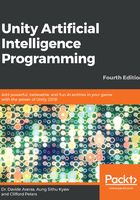
AI in games
Game AI needs to complement the quality of a game. For that, we need to understand the fundamental requirement that every game must have. The answer should be easy: the fun factor. So, what makes a game fun to play? Answering this question is the subject of game design, and a good reference is The Art of Game Design by Jesse Schell. Let's attempt to tackle this question without going deep into game design topics. We'll find that a challenging game is indeed fun to play. Let me repeat: it's about making a game challenging. This means the game should not be so difficult that it's impossible for the player to beat the opponent, or too easy to win. Finding the right challenge level is the key to making a game fun to play.
And that's where the AI kicks in. The role of AI in games is to make it fun by providing challenging opponents to compete, and interesting Non-Player Characters (NPCs) that behave realistically inside the game world. So, the objective here is not to replicate the whole thought process of humans or animals, but to make the NPCs seem intelligent by reacting to the changing situations inside the game world, in a way that makes sense to the player.
The reason that we don't want to make the AI system in games so computationally expensive is that the processing power required for AI calculations needs to be shared between other operations, such as graphics rendering and physics simulation. Also, don't forget that they are all happening in real time, and it's critical to achieving a steady frame rate throughout the game. There were even attempts to create a dedicated processor for AI calculations (AI seek's Intia Processor or the Google's Tensorflow processing unit). With the ever-increasing processing power, we now have more and more room for AI calculations. However, like all of the other disciplines in game development, optimizing AI calculations remains a considerable challenge for the AI developers.